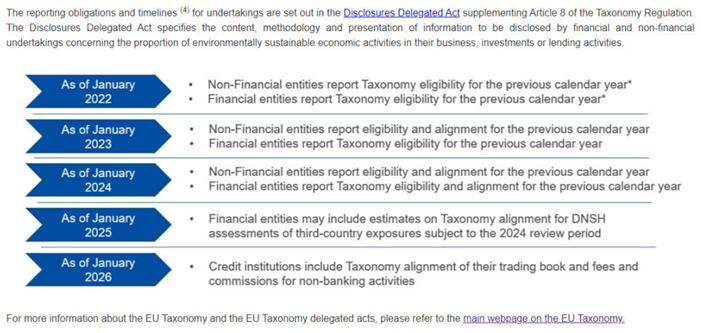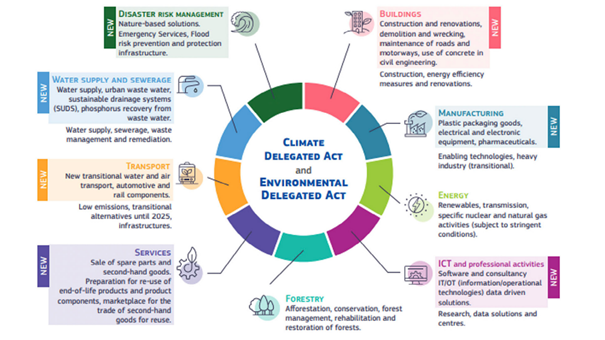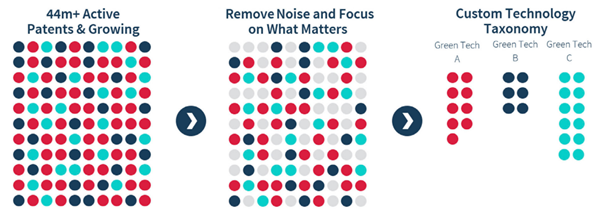TTO Approach To Identifying Green Science Using AI For Technology Transfer
By Magda Voltolini, Dr. Naceur Tounekti, and Steve Harris
This article was originally published in les Nouvelles – December 2023.
Summary
The goal of this article is to provide considerations for identifying “green academic patents” using artificial intelligence (AI) for technology transfer, while also acknowledging the challenges of ensuring an effective patent portfolio classification by green science.
In addition, the authors propose to begin a discussion of scientific criteria to classify green science in a patent portfolio that can be considered as part of the European Corporate Sustainability Reporting, and therefore eligible for the upcoming European mandatory sustainable compliance report.
This article does not address the non-mandatory sustainable compliance report related to Sustainable Development Goals (SGD) of the United Nations.
I . Background: European Green Deal
From the standpoint of European businesses and research institutions, European regulators anticipate that innovators will gradually assist in identifying, developing, investing, licensing and evaluating sustainable products and services throughout their life cycle.
The European Union is committed to implementing the 2030 Agenda for Sustainable Development, which focuses on economic, social, and environmental sustainability. The European Commission communication for a sustainable European future linked the SDGs to the Union policy framework, and the Council’s conclusions confirmed this commitment in 2017. The European Commission released a communication in December 2019 introducing the “The European Green Deal.”
In accordance with the numerous directives emanating from the European Green Deal, (“Fit for 55: Delivering on the Proposals”), EU industries and academic institutions are developing new strategies to contribute to a climate-neutral continent by 2050. Climate-neutral technologies comprise new sustainable construction (Francesco) (Yuyan et al.), new sustainable maritime freight services (Ashish and Saurabh), new smart railway stations (Hasan et al.) and so on.
In addition, sustainable finance is a key part of the European Green Deal. European financial regulators stipulate that stakeholders meeting certain criteria will be legally bound to provide non-financial reporting to investors to demonstrate sustainability compliance. (“Corporate Sustainability Reporting”). See Figure 1. The new Corporate Sustainability Reporting Directive, sometimes known as the “CSRD” (EU 2022/2464), will go into effect on 1 January 2024, and as a result of the new “European Sustainability Reporting Standards” (ESRS), large companies and small and medium-sized companies listed on European regulated markets, except micro-enterprises, will have to comply with “the sustainability reporting standards” in accordance with Articles 19a and 29b of the CSRD. The new standards require disclosure of environmental, social, and governance issues, including climate change, biodiversity, and human rights strategies to inform investors of sustainable impact. These standards will be established by the European Commission through delegated acts. (“Publication of the New Directive on Corporate Sustainability Reporting (CSRD)”) (Corporate Sustainability Reporting) (“EUR-Lex 32022L2464-EN-EUR-Lex”).
Therefore, innovation, sustainable financing and environmental regulations are the main pillars of the EU’s policy on climate sustainable development. Such policies have a direct impact on research and innovation, and most precisely on patent filing, patent portfolio assessment and intellectual property transactions.

Figure 1: EU Taxonomy Delegated Acts
A . Literature: Regulatory Influence in Environmental Innovation
It is crucial to consider the influence of regulatory measures on the advancement of environmentally sustainable innovations. With the objective of achieving this goal, presented below is a concise literature review that offers a limited number of findings.
Nameroff and his colleagues looked into what happened with green chemistry patents in the U.S. between 1983 and 2001. They learned that most industry sectors paid less attention to green chemistry than the university and government sectors. Additionally, the focus on U.S. green chemistry patents grew the most in the late 1980s and early 1990s, around the same time that major U.S. environmental laws were changed. Still, businesses in other areas of chemical science did not use green chemistry to cut down on regulations (Nameroff et al.).
The Nameroff et al. study looked at patent data to figure out why and how green chemistry research and development (R&D) had changed over time. Still, they found that patent information was not the best way to find out if companies were making the most of their resources during that period (Nameroff et al.).
Kisedou and Wu investigated the influence of tougher environmental regulation on the generation of green patents by Chinese enterprises using variation in pollution reduction objectives across provinces and temporal changes before and after the 11th Five-Year Plan (“11th Five-Year Plan (2006-2010) for National Economic and Social Development | ESCAP Policy Documents Management”). They discovered that Chinese manufacturing enterprises in regions with tougher environmental standards created a greater number and intensity of green patents. Their findings indicated that tougher environmental regulatory frameworks in emerging economies were not just tackling pollution but also moving manufacturing enterprises’ innovative efforts towards accumulating a stock of knowledge in environmental protection (Kesidou and Wu).
As to the role of public research networks in environmental innovation, the literature is far less developed and recent than that of environmental regulation (Fabrizi et al.). Frabrizi et al. used the open eco-innovation mode and the Porter Hypothesis combined in their theory to apply them to the knowledge production function and make green patents a dependent variable. They looked at the variables that affect the production of green patents over time for a group of European countries as a measure of new “environmental” knowledge. They found that European regulation policies and research networks positively impact innovation, highlighting the importance of combining these policies with appropriate innovation strategies for enhanced effectiveness (Fabrizi et al.).
B . EU Taxonomy
The EU Taxonomy is a standardized classification system laid down in the Regulation (EU) 2020/852 establishing sustainable activities according to EU policies. Its goal is to harmonize standards and promote investments in sustainable activities that will enable Europe to achieve a net-zero economy by 2050 (“EU Taxonomy for Sustainable Activities”). See Figure 2.

Figure 2: EU Taxonomy Economic Sectors And Activities Covered. Source: “European Commission: Finance.” EU Taxonomy for Sustainable Activities, June 2023.
The EU Taxonomy is closely linked to the new Corporate Sustainability Reporting Directive. To align with the EU Taxonomy, companies’ economic activities must report quantitative and qualitative Environmental, Social and Governance indicators, as required by the New Sustainability Standards. See Table 1.
 Table 1: EU Taxonomy, Companies’ Economic Activities. Source: Article 29b of Directive (EU) 2022/2464.
Table 1: EU Taxonomy, Companies’ Economic Activities. Source: Article 29b of Directive (EU) 2022/2464.
Companies subject to the CSRD must indicate in their annual reports the extent to which their operations are covered by the EU Taxonomy and adhere with the delegated acts (“Implementing and Delegated Acts-Taxonomy Regulation”).
In parallel, the EU Taxonomy also interacts with the EU’s Sustainable Financial Disclosure Regulation (SFDR). The EU co-legislators and the European Commission created the SFDR as an Environmental, Social, and Governance (ESG) transparency framework for financial companies and products. As a result, the legislation mandates financial market players to report data on their sustainability messaging and practices (“Sustainability-related Disclosure in the Financial Services Sector”).
II . What Are Green Technologies? What Is Green Science?
Green technologies are environmentally sound technologies as defined in Chapter 34 of Agenda 21 (The United Nations Program of Action from Rio, 1992). Green technologies “protect the environment, are less polluting, use all resources in a more sustainable manner, recycle more of their wastes and products, and handle residual waste in a more acceptable manner than the technologies for which they were substitutes.” These “include know-how, procedures, goods and services, and equipment as well as organizational and managerial procedures.” (“Frequently Asked Questions: WIPO GREEN: What Is a ‘Green Technology’”).
It is important to note that there is currently no universally accepted or internationally recognized definition of green technology (“Low Carbon Green Growth Roadmap for Asia and the Pacific: Fact Sheet—Green Technology”). As a result, industries have developed their own approaches and terminologies for identifying and categorizing green inventions within their large patent portfolios (for example, L’Oréal successfully identified green science in their 120,000-patent portfolio of Cosmetics by training AI models and publishing the results and the steps involved of each phase) (Soutrenon et al.).
Considering that certain large companies may declare patents as green technology without any technical analyses, in Europe, this will no longer be possible as of 2028.
III. Connection Between Green Patents, LCA, and SCR
Indeed, there is a connection between Life Cycle Assessment (LCA), Sustainability Compliance Reporting (SCR), and green patents in terms of promoting sustainability and fostering innovation. However, these are separate methods with unique objectives.
- Life Cycle Assessment (LCA) is used to evaluate and track the ecological impact of products and processes.
- Sustainability Compliance Reporting (SCR) is employed to verify adherence to sustainability criteria.
- Finally, green patents cover inventions that include new and innovative environmentally conscious ingredients, materials, methods, and processes.
In short, there are numerous challenges and viewpoints surrounding the classification of green patents and sustainability reports. Fortunately, new and standardized solutions and regulations are on the way. To limit the topic of patent classification of green science, in this article, we suggest a method to classify green patents, using AI based on technical criteria as follows.
A . Green Science and AI Classifiers
1 . Using AI to Classify Green Patents — Where Are There Proven Classification Models?
To understand what may be possible, we will look at Cipher’s efforts in this area as an example. Cipher started using AI to classify patents into pre-defined technology landscapes 10 years ago and has built over 9,000 classifiers. The algorithm behind the AI that classifies patents has been independently tested for accuracy and there are a number of learnings from how to build the training set for a classifier.
Cipher’s algorithm can read over 60 million patents an hour, which enables scanning every single patent globally to find green patents in a particular area. Patent data structure is inconsistent and CPC codes are not used uniformly, hence being able to scan the global patent landscape of 44 million active patents or 100 million total patents is useful to ensure you have all the green patents relating to a particular green technology. See Figure 3.
Cipher’s machine learning (ML) technology is custom built for classifying patents, not a standard text system that’s been repurposed. Cipher has dedicated processing for the data that makes patents unique, in order to get the most accurate classification.

Figure 3: Using AI To Cut Out The Noise
2 . Testing the AI
One of the great things about ML algorithms is that it’s easy to test their accuracy scientifically. In order to do that, Cipher took some test data generated by an independent third party. The third party was Tony Trippe, who at the time was Director of Patinformatics, which is a patent landscaping advisory firm. The data was split into two parts — inside the topic, and outside the topic (but still relevant).
The classifiers were then trained on a portion of the data and tested against the remainder, using a process described by Harris et al. in “Construction and evaluation of gold standards for patent classification,” published in World Patent Information in 2020 (Harris et al.).
The two topics used to test the Cipher ML algorithm were Quantum Computing Q-bit Generation, and Cannabinoid Edibles. The results are shown for both a small training set (the patents used to train the classifier) of 150 families, medium at 250, and large at 350 families. The results of the tests, averaged over 100 runs, are shown in Table 2 and Figure 4.
 Table 2: Two Topics Used To Test The Cipher ML Algorithm
Table 2: Two Topics Used To Test The Cipher ML Algorithm

Figure 4: Charts Displaying The Recall And Precision Scores’ Ranges. Figure 4 shows how the accuracy (F1) of the classifier improves with larger training sets (T), as published in World Patent Information 2020 by Harris et al.
3 . Key Learnings
- The AI is only having good results as you define the classifier/inputs
- Having a clear scope of what you define as “green” and what you define as “not green” is key to get the accurate result set.
- The algorithm learns best to build the patent classifier by using these elements of a patent as they produce the best performing classifiers:
- Title, Abstract, Claims — Text analysis, natural language processing and removal of common phrasing
- CPC Classes — Deep learning model for CPC relationships, usage instead of hierarchy
- Citations — Relation analysis
- Using several different data points to build your training set will ensure a better result set. Using other academic literature allows for a diversified set of patents to be developed for your training set.
- Having a good training set is key to ensuring a well performing classifier. The training set needs to be scoped well, representative, diversified and balanced.
- Being able to identify patents that are similar to develop your training set is key. The Cipher classifier builder is also a similar family feature that finds new and related patents to strengthen the training set.
B. Academic Green Patents for Tech Transfer
France unveiled the national strategies for technology transfer earlier this year as part of the France 2030 program to promote sustainable development and industrialization. The plan aims to encourage the establishment of new startups and the transfer of environmentally friendly technology and digital solutions (France 2030: Faire Émerger Davantage De Start-up Issues De La Recherche).
The 17 strategies identified key sectors of focus covering a wide range of areas, such as sustainable food, batteries, biotherapies, cybersecurity, decarbonization, and much more, as shown in Table 3.
Indeed, one can assume that large European companies are interested in engaging with public research and development or obtaining intellectual property assets via technology transfer since public research laboratories prioritize emerging technologies that have shown efficacy in their LCA or have a proven scientific criterion aligned with European sustainable compliance standards. Additionally, they must identify green patents in their large patent portfolios to ensure sustainable compliance.

Table 3: The 17 Strategies Identified Key Sectors Of Focus. Source: (France 2030 : Faire Émerger Davantage De Start-up Issues De La Recherche).
1 . The Sci-ty Consortium
One of the most important issues for the French national strategies to accelerate technology transfer is the classification of intellectual property portfolios.
In order to exemplify this methodology, we will outline the steps taken by the Sci-ty consortium below. This consortium is tasked with the early and final development stages of technologies pertaining to two national strategies: “Ville Durable et Batîments Innovants (VDBI),” which focuses on creating solutions for sustainable cities and innovative buildings, and “Digitalisation et Décarbonation de Mobilités (DDM),” which focuses on creating solutions for digitalization and decarbonization of mobilities.
Sci-ty is a consortium consisting of 25 members, including 19 public research establishments and six technology transfer offices (SATT). Its main goal is to establish a support system for innovative projects with high potential to expedite the technology transfer to the socio-economic sector. This initiative aligns with the two national acceleration strategies. Additionally, Sci-ty’s ultimate ambition is to encourage the emergence and structuring of a community of experts (scientists, local authorities, socio-economic players) in different French regions, who will keep the virtuous circle of innovation alive in the long run, making it ever more solvent by assisting in the transformation of our entire economy towards carbon neutrality.
The two organizations leading the Sci-ty consortium are Gustave Eiffel University (UGE), which oversees the early-stage phase, and Erganeo, a technology transfer office in charge of the final development stage phase.
On 1 January 2020, the Gustave Eiffel University or UGE was created as a result of the consolidation of multiple institutions. Today, it has 17,000 students and 2,300 staff members, including 1,200 researchers and teacher-researchers who work in its 23 research departments on the various campuses — they have recognized specializations in the fields of sustainable cities and mobility, among others. The UGE is particularly known for its expertise in sustainable cities and mobility, and excels in Shanghai’s thematic rankings, specifically in the field of transport science and technology, where it is ranked among the top 49 institutions globally. Notably, it holds top position in France in this particular field. Presently, UGE’s Paris site is responsible for conducting approximately 25 percent of France’s urban research.
SATT Erganeo focuses on technology transfer and specializes in innovations that have a significant impact on society. As a technology transfer subsidiary of its shareholder institutions, it funds projects originating from academic laboratories across various scientific domains, including Biotech (health, environment, cosmetics), Infotech (telecoms, internet of things, big data, AI), Enertech (green energies, chemistry, materials), and more. The objective is to expedite the transfer of technology to industry. The organization’s objective is to safeguard, cultivate, expedite, and streamline the collaborations between research and industry in support of ethical and sustainable advancement.
Since its establishment in 2012, Erganeo has allocated over €42 million towards the development and advancement of projects. It has provided support to over 200 initiatives and facilitated the signing of approximately 100 licensing agreements with companies of various scales. It has additionally facilitated the establishment of over 30 start-up companies and managed a portfolio of over 500 intellectual property assets on behalf of its diverse shareholder institutions and organizations.
2 . Steps to Identify Green Patents in the Sci-ty Portfolio Using AI Classifiers
- Identifying all patent owners participating in the consortium
- Determining the level of granularity of a classifier with stakeholders
- Clearly delimiting the technical domains to create a classifier
- Identifying and creating a body of academic scientists to work closely with organizations like Cipher to validate the positive and negative patents to include in a classifier
- Having a clear idea of priorities and timeline since it takes time to train the machine
IV . Main Points for Further Discussion
1 . The need for identifying “green academic patents” using AI for technology transfer and the challenges of patent portfolio classification by green science.
2 . The scientific criteria to classify green science in a patent portfolio as part of the European Corporate Sustainability Reporting and the upcoming European mandatory sustainable compliance report.
3 . The impact of European Green Deal policies on research, innovation, patent filing, patent portfolio assessment, and intellectual property transactions.
4 . The influence of regulatory measures on environmentally sustainable innovations, including the focus on green chemistry patents and the impact of tougher environmental regulation on the generation of green patents.
5 . The role of public research networks in environmental innovation and the positive impact of European regulation policies and research networks on innovation.
6 . The definition and categorization of green technologies, the lack of a universally accepted definition, and the development of industry-specific approaches for identifying and categorizing green inventions within patent portfolios.
7 . The connection between green patents, Life Cycle Assessment (LCA), Sustainability Compliance Reporting (SCR), and the promotion of sustainability and innovation.
8 . The use of AI classifiers to classify green patents, including the proven classification models and the ability to scan the global patent landscape to find green patents in specific areas.
V . Works Cited
“11th Five-Year Plan (2006-2010) for National Economic and Social Development | ESCAP Policy Documents Managment.” 11th Five-Year Plan (2006-2010) for National Economic and Social Development | ESCAP Policy Documents Managment, policy.asiapacificenergy.org/node/115. Accessed 17 Aug. 2023.
Ashish, Dwivedi, and Pratap. “Sustainable Maritime Freight Transportation: Current Status and Future Directions Saurabh. Sustainability 15 No. 8, 2023.
Communique de Presse Erganeo. 10 Jan. 2023, www.erganeo.com/sites/default/files/inline-files/2023_01_CP%20projet%20SCI-Ty.pdf.
“Corporate Sustainability Reporting.” European Commission, 31 July 2023, finance.ec.europa.eu/capital-markets-union-and-financial-markets/company-reporting-and-auditing/company-reporting/corporate-sustainability-reporting_en.
“Corporate Sustainability Reporting.” Finance, 31 July 2023, finance.ec.europa.eu/capital-markets-union-and-financial-markets/company-reporting-and-auditing/company-reporting/corporate-sustainability-reporting_en.
“EU Taxonomy for Sustainable Activities.” Finance, finance.ec.europa.eu/sustainable-finance/tools-and-standards/eu-taxonomy-sustainable-activities_en. Accessed 16 Oct. 2023.
“EUR-Lex – 32020R0852 – EN – EUR-Lex. ” EUR-Lex—32020R0852 – EN – EUR-Lex, eur-lex.europa.eu/legal-content/EN/TXT/?uri=celex%3A32020R0852. Accessed 18 Oct. 2023.
“EUR-Lex – 32022L2464 – EN – EUR-Lex.” EUR-Lex – 32022L2464 – EN – EUR-Lex, eur-lex.europa.eu/legal-content/EN/TXT/?uri=CELEX:32022L2464. Accessed 24 Aug. 2023.
“European Commission: Finance.” EU Taxonomy for Sustainable Activities, June 2023, finance.ec.europa.eu/system/files/2023-06/230613-sustainable-finance-factsheet_en_0.pdf.
Fabrizi, Andrea, et al. “Green Patents, Regulatory Policies and Research Network Policies.” Green Patents, Regulatory Policies and Research Network Policies -ScienceDirect, 16 Mar. 2018, www.sciencedirect.com/science/article/abs/pii/S0048733318300556.
“Fit for 55: Delivering on the Proposals.” European Commission, commission.europa.eu/strategy-and-policy/priorities-2019-2024/european-green-deal/delivering-european-green-deal/fit-55-delivering-proposals_en. Accessed 12 Oct. 2023.
France 2030: Faire Émerger Davantage De Start-up Issues De La Recherche. 9 Jan. 2023, www.enseignementsup-recherche.gouv.fr/sites/default/files/2023-01/dossier-de-presse—france-2030-faire-merger-davantage-de-start-up-issues-de-la-recherche-26053.pdf.
“Frequently Asked Questions: WIPO GREEN: What Is a ‘Green Technology.’” WIPO Green, www3.wipo.int/wipogreen/en/faqs.html. Accessed 7 Sept. 2023.
Harris, Steve, et al. “Construction and Evaluation of Gold Standards for Patent classification—A Case Study on Quantum Computing.” World Patent Information, vol. 101961, Elsevier BV, 1 June 2020, https://doi.org/10.1016/j.wpi.2020.101961.
Hasan, Can Kılıçkıran, et al. IEEE Transactions on Sustainable Energy 9 No. 3, 2017.“Implementing and Delegated Acts—Taxonomy Regulation.” European Commission, finance.ec.europa.eu/regulation-and-supervision/financial-services-legislation/implementing-and-delegated-acts/taxonomy-regulation_en. Accessed 18 Oct. 2023.
Kesidou, Effie, and Lichao Wu. “Stringency of Environmental Regulation and Eco-innovation: Evidence From the Eleventh Five-Year Plan and Green Patents.” Stringency of Environmental Regulation and Eco-innovation: Evidence From the Eleventh Five-Year Plan and Green Patents — ScienceDirect, 19 Mar. 2020, www.sciencedirect.com/science/article/abs/pii/S0165176520300823.
“Low Carbon Green Growth Roadmap for Asia and the Pacific: Fact Sheet — Green Technology.” UNESCAP, www.unescap.org/sites/default/files/34.%20FS-Green-Technology.pdf. Accessed 7 Sept. 2023.
Nameroff, T. J., et al. “Adoption of Green Chemistry: An Analysis Based on U.S. Patents.” Adoption of Green Chemistry: An Analysis Based on U.S. Patents — ScienceDirect, 7 May 2004, www.sciencedirect.com/science/article/abs/pii/S0048733304000502.
“Publication of the New Directive on Corporate Sustainability Reporting (CSRD).” Autorité Des Marchés Financiers (AMF), 17 Jan. 2023, www.amf-france.org/en/news-publications/news/publication-new-directive-corporate-sustainability-reporting-csrd.
“Questions and Answers on the Adoption of European Sustainability Reporting Standards.” European Commission, 31 July 2023, ec.europa.eu/commission/presscorner/home/en.
Radojcin, Catherine. “New Developments to the CSRD: What Are the Implications for Non-financial Disclosures?” EcoAct, 13 Oct. 2023, eco-act.com/tcfd/csrd-non-financial-disclosure-in-eu.
Ronald, McCaffer, et al. Modern Construction Management. John Wiley Sons, 2021.
Soutrenon, Pauline, et al. “Analyzing Green Science-related Patents in Cosmetics by Using Artificial Intelligence.” World Patent Information, 1 Sept. 2023, doi.org/10.1016/j.wpi.2023.102223.
“Sustainability-related Disclosure in the Financial Services Sector.” European Commission, finance.ec.europa.eu/sustainable-finance/disclosures/sustainability-related-disclosure-financial-services-sector_en. Accessed 18 Oct. 2023.
Université Gustave Eiffel. Transforming Life and Cities. www.univ-gustave-eiffel.fr/fileadmin/UniversiteGustaveEiffel/Universite/Plaquette_presentation/Plaquette-presentation-Eiffel-EN.pdf. Accessed 13 Nov. 2023.
Yuyan, Tang, et al. “Collaborative Relationship Discovery in Green Building Technology Innovation Evidence From Patents in Chinas Construction Industry.” Journal of Cleaner Production 391, 2023.
About the authors:
 Magda Voltolini is Intellectual Property Mangager at Erganeo. As an IP Portfolio Manager for the Sci-ty program, she is responsible for monitoring and analyzing the intellectual property portfolio for the two National Acceleration Strategies:
Magda Voltolini is Intellectual Property Mangager at Erganeo. As an IP Portfolio Manager for the Sci-ty program, she is responsible for monitoring and analyzing the intellectual property portfolio for the two National Acceleration Strategies:
– Sustainable City and Innovative Buildings (VDBI) and,
– Digitization and Decarbonization of Mobility (DDM).
Dr. Naceur Tounekti, Chief Executive Officer, Erganeo, Paris, France
Steve Harris, Chief Technology Officer, Cipher, London, England



